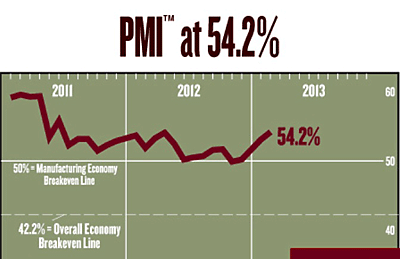 Economic activity in the U.S. manufacturing sector expanded in February for the third consecutive month, and the overall economy grew for the 45th consecutive month, say the nation's supply executives in the latest Manufacturing ISM (Institute of Supply Management) Report On Business®. The report was issued this week by the ISM Manufacturing Business Survey Committee, Tempe, Ariz., USA.
Economic activity in the U.S. manufacturing sector expanded in February for the third consecutive month, and the overall economy grew for the 45th consecutive month, say the nation's supply executives in the latest Manufacturing ISM (Institute of Supply Management) Report On Business®. The report was issued this week by the ISM Manufacturing Business Survey Committee, Tempe, Ariz., USA.
The PMI registered 54.2%, an increase of 1.1 percentage points from January's reading of 53.1%, indicating expansion in manufacturing for the third consecutive month. This month's reading reflects the highest PMI since June 2011, when the index registered 55.8%. The New Orders Index registered 57.8%, an increase of 4.5% over January's reading of 53.3%, indicating growth in new orders for the second consecutive month. As was the case in January, all five of the PMIs component indexes—new orders, production, employment, supplier deliveries, and inventories—registered in positive territory in February. In addition, the Backlog of Orders, Exports, and Imports Indexes all grew in February relative to January.
Of the 18 manufacturing industries, 15 are reporting growth in February in the following order: Apparel, Leather and Allied Products; Miscellaneous Manufacturing; Paper Products; Electrical Equipment, Appliances and Components; Plastics and Rubber Products; Fabricated Metal Products; Furniture and Related Products; Petroleum and Coal Products; Wood Products; Printing and Related Support Activities; Transportation Equipment; Nonmetallic Mineral Products; Food, Beverage, and Tobacco Products; Machinery; and Primary Metals. The three industries reporting contraction in February are: Textile Mills; Computer and Electronic Products; and Chemical Products.
The 15 industries reporting growth in new orders in February (in order) are: Apparel, Leather, and Allied Products; Furniture and Related Products; Miscellaneous Manufacturing; Paper Products; Machinery; Nonmetallic Mineral Products; Fabricated Metal Products; Transportation Equipment; Plastics and Rubber Products; Primary Metals; Electrical Equipment, Appliances and Components; Food, Beverage, and Tobacco Products; Computer and Electronic Products; Chemical Products; and Petroleum and Coal Products. The only industry reporting a decrease in new orders during February is Wood Products.
ISM's Production Index registered 57.6% in February, which is an increase of 4 percentage points when compared with the 53.6% reported in January. This indicates growth in production for the sixth consecutive month. An index above 51.2%, over time, is generally consistent with an increase in the Federal Reserve Board's Industrial Production figures.
The 13 industries reporting growth in production during the month of February (in order) are: Wood Products; Paper Products; Electrical Equipment, Appliances and Components; Miscellaneous Manufacturing; Primary Metals; Apparel, Leather, and Allied Products; Printing and Related Support Activities; Fabricated Metal Products; Transportation Equipment; Plastics and Rubber Products; Food, Beverage, and Tobacco Products; Computer and Electronic Products; and Machinery. The four industries reporting a decrease in production in February are: Textile Mills; Petroleum and Coal Products; Chemical Products; and Furniture and Related Products.
ISM's Employment Index registered 52.6% in February, which is 1.4 percentage points lower than the 54% reported in January. This month's reading indicates growth in employment for the 41st consecutive month. An Employment Index above 50.5%, over time, is generally consistent with an increase in the Bureau of Labor Statistics (BLS) data on manufacturing employment.
Of the 18 manufacturing industries, 10 reported growth in employment in February in the following order: Petroleum and Coal Products; Apparel, Leather, and Allied Products; Paper Products; Printing and Related Support Activities; Furniture and Related Products; Electrical Equipment, Appliances and Components; Miscellaneous Manufacturing; Plastics and Rubber Products; Fabricated Metal Products; and Primary Metals. The five industries reporting a decrease in employment in February are: Chemical Products; Transportation Equipment; Computer and Electronic Products; Machinery; and Wood Products.
The Inventories Index registered 51.5% in February, which is 0.5 percentage point higher than the 51% in January. This month's reading indicates that respondents are reporting that inventories are growing in February for the second consecutive month. An Inventories Index greater than 42.7%, over time, is generally consistent with expansion in the Bureau of Economic Analysis' (BEA) figures on overall manufacturing inventories (in chained 2000 dollars).
The nine industries reporting higher inventories in February (in order) are: Apparel, Leather, and Allied Products; Wood Products; Plastics and Rubber Products; Petroleum and Coal Products; Transportation Equipment; Miscellaneous Manufacturing; Chemical Products; Fabricated Metal Products; and Food, Beverage, and Tobacco Products. The six industries reporting decreases in inventories in February (in order) are: Textile Mills; Primary Metals; Furniture and Related Products; Paper Products; Computer and Electronic Products; and Nonmetallic Mineral Products.
The full text version of the Manufacturing ISM Report on Business is available online.
TAPPI
http://www.tappi.org/